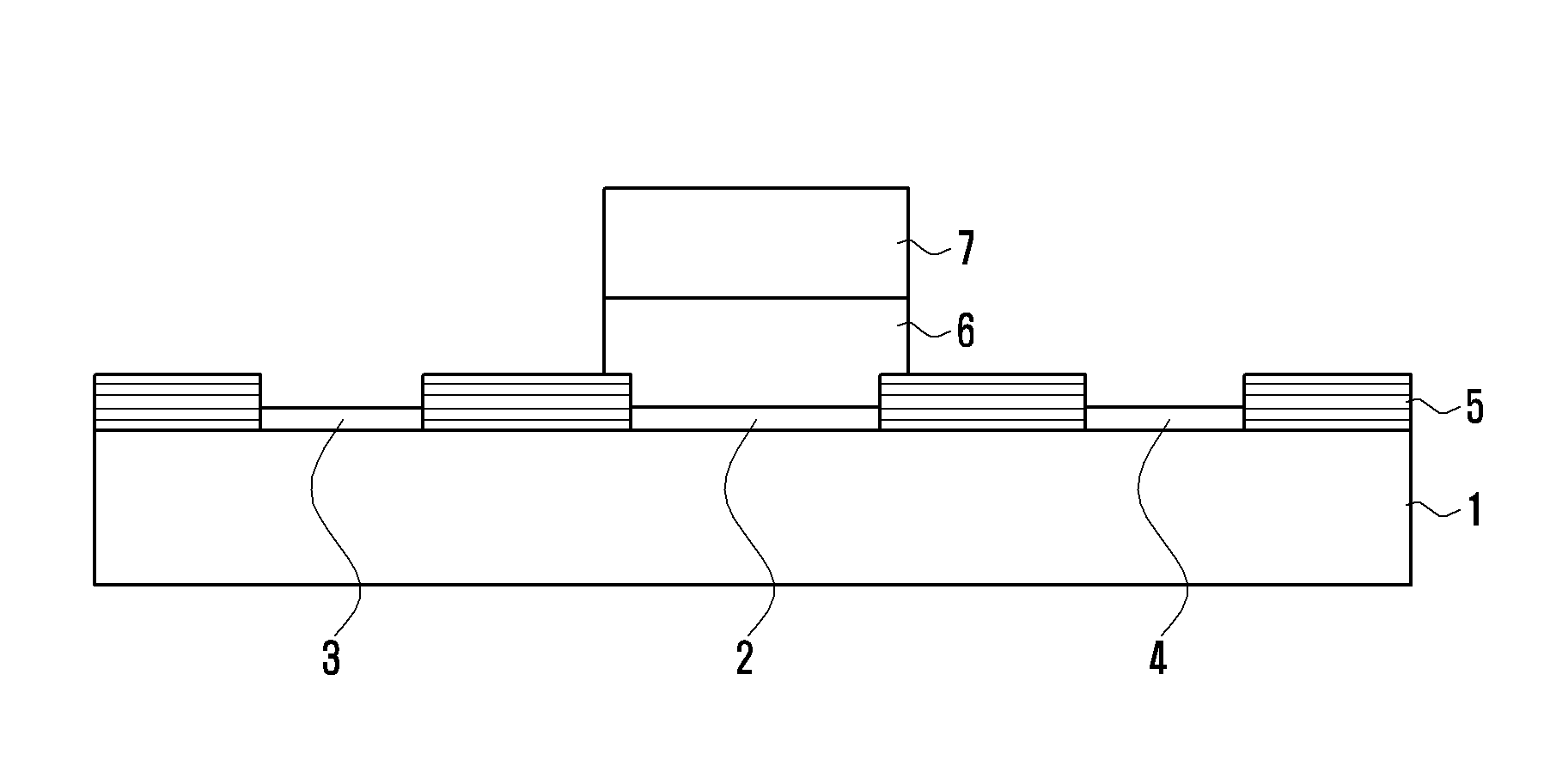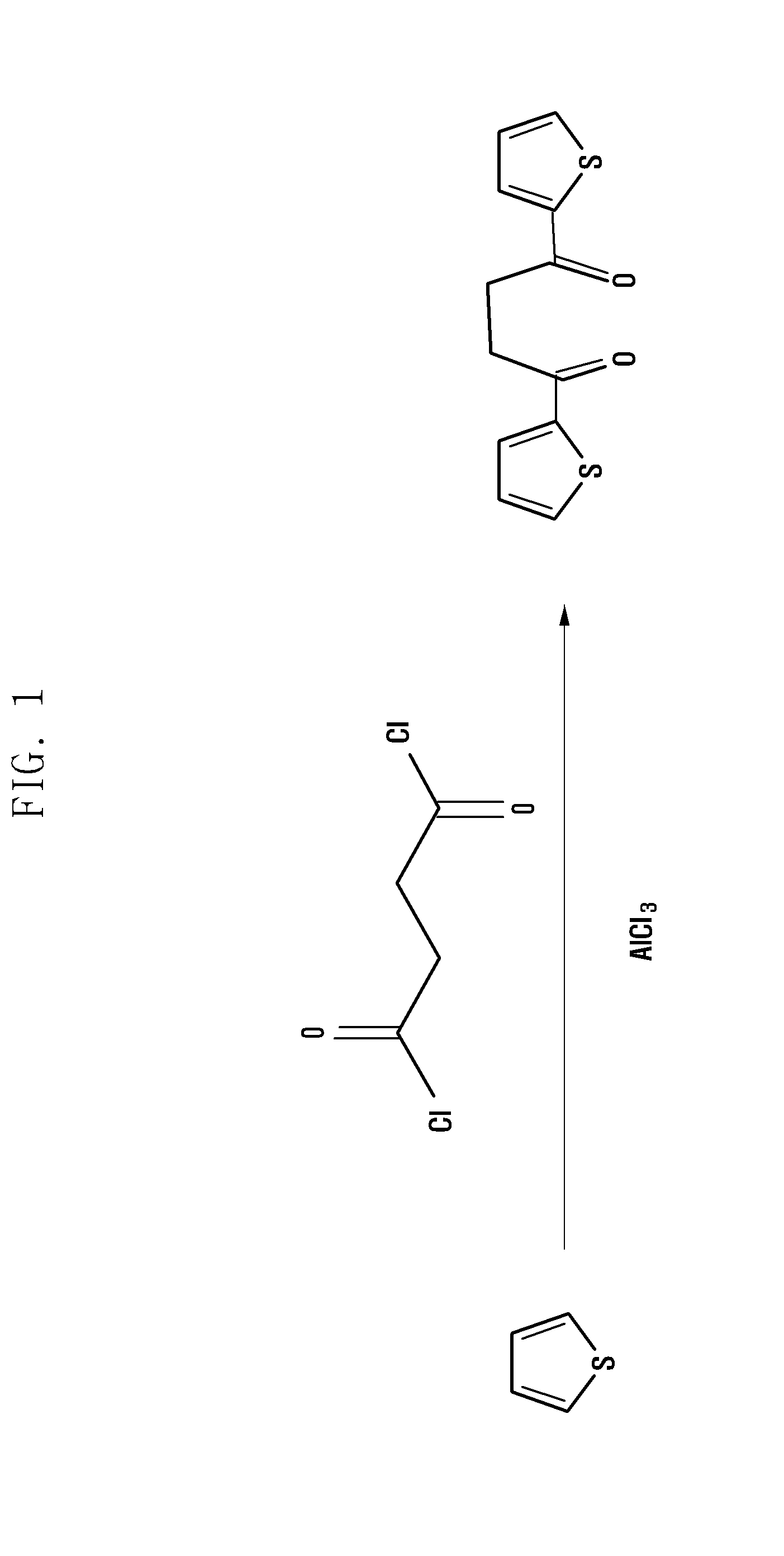Electron transfer mediators for enzyme-based biosensor
a biosensor and electron transfer technology, applied in the field of new ferrous complexes, can solve the problems of reducing the sensitivity of blood glucose measurement for a glucose sensor, the difficulty of directly transferring electrons generated by an oxidization of the substrate to the electrode, and the electron transfer mediator available for a reaction with enzymes is reduced, and achieves excellent sensitivity and strong absorbability.
- Summary
- Abstract
- Description
- Claims
- Application Information
AI Technical Summary
Benefits of technology
Problems solved by technology
Method used
Image
Examples
example 1
Preparation of New Ferrous Complex
[0036]Used Materials:
[0037]Thiophene, succinyl chloride, 1,10-phenanthrolin-5-amine, and p-toluene sulfonic acid (PTSA) were purchased from Sigma (USA). AlCl3 was purchased from Junsei (Japan). Dichloromethane, toluene, and ethanol were purchased from Dae-Jung (Korea). NAD-GDH was purchased from Toyobo (Japan), and NAD and Nafion (5%) were purchased from Sigma (USA).
Step 1: Synthesis of 4-di(2-thienyl)-1,4-butanedione
[0038]120 mM thiophene and 50 mM succinyl chloride were dissolved in 100 ml of 99.8% dichloromethane as a reaction solvent, and then reacted for 10 minutes. Then, 16 g of AgCl3 was added and reacted at 18° C. to 20° C. for 12 hours. The resulting product was washed with sodium bicarbonate and water, and treated with 5 g of MgSO4 for removing the solvent to obtain a dark green product. Such a dark green product was washed with ethanol to obtain 4-di(2-thienyl)-1,4-butanedione that was a pale blue solid. The structure of the pale blue sol...
example 2
Manufacture of Glucose Sensor using Ferrous Complex According to the Present Invention
[0044]1.0 μl of a solution that was prepared by dissolving 1.0 mM of the ferrous complex prepared according to Example 1 as described above in 99.5% ethanol was dropped on the top of a working electrode formed of a screen-printed carbon electrode (SPCE), and then dried at a room temperature for 30 seconds. 1.0 μl of 4.0 mg / ml solution that was prepared by dissolving NAD-glucose dehydrogenase (NAD-GDH) in distilled water was dropped on the dried electrode, and then dried at room temperature for 30 seconds. 1.0 μl of 1.0% Nafion solution was dropped thereon to form a protective layer of the ferrous complex and NAD-GDH. As a result, a glucose sensor was manufactured. As electrode of the glucose sensor, screen-printed carbon electrode including the working electrode, an auxiliary electrode, and a reference electrode was used, in which the working electrode and auxiliary electrode were manufactured by u...
experimental example 1
Experiment for Measuring Oxidation-Reduction Current of Ferrous Complex According to Scanning Speed
[0046]In order to confirm a change in the relationship of oxidation-reduction current according to a change of potential scanning speed of the new ferrous complex according to the present invention, the following experiment was performed.
1.0 mM ferrous complex prepared according to Example 1 was dissolved in a solution of dimethyl sulfoxide (DMSO) / 0.1M tetrabutyl ammonium perchlorate (TBAP), and a change of oxidation-reduction current was measured by changing the scanning speed from 10 mV / s to 250 mV / s at a potential range of 0.0 V to 0.8 V by cyclic voltammetry using a glassycarbon electrode. The results are shown in FIG. 5.
[0047]From the result in FIG. 5, it can be confirmed that the oxidation-reduction current value of the ferrous complex according to the present invention is proportional to the square root of the scanning speed.
[0048]In addition, from the above results, the electro...
PUM
| Property | Measurement | Unit |
|---|---|---|
| pH | aaaaa | aaaaa |
| Chemical Formula | aaaaa | aaaaa |
| concentration | aaaaa | aaaaa |
Abstract
Description
Claims
Application Information
 Login to View More
Login to View More - R&D
- Intellectual Property
- Life Sciences
- Materials
- Tech Scout
- Unparalleled Data Quality
- Higher Quality Content
- 60% Fewer Hallucinations
Browse by: Latest US Patents, China's latest patents, Technical Efficacy Thesaurus, Application Domain, Technology Topic, Popular Technical Reports.
© 2025 PatSnap. All rights reserved.Legal|Privacy policy|Modern Slavery Act Transparency Statement|Sitemap|About US| Contact US: help@patsnap.com



